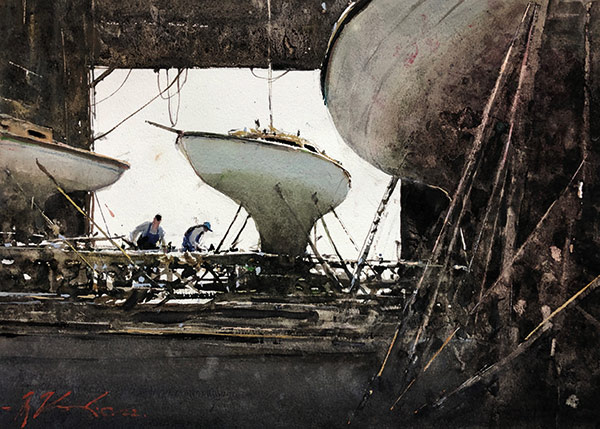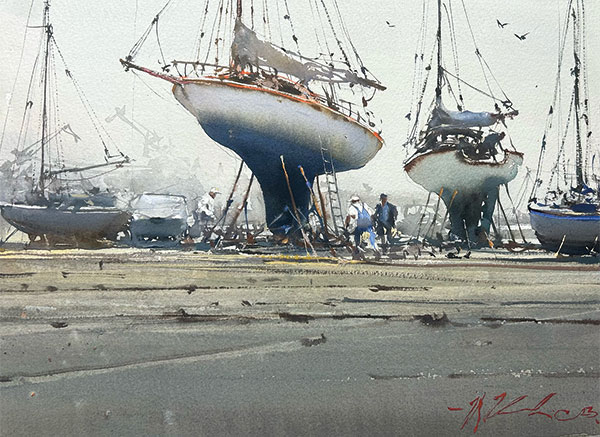Subtotal: $
Checkout
In Praise of Repair Culture
Modern life depends on the habit of discarding things. What if we fixed them instead?
By Peter Mommsen
December 4, 2023
Next Article:
Do farmers have a right to repair their own tractors? The American Farm Bureau Federation thinks so. That’s why this year it reached an agreement with John Deere in which the manufacturer promised to enable farmers, as well as third-party mechanics, to fix their own green-and-yellow machinery, for example by providing service manuals and diagnostic tools that earlier only licensed shops could access. For many farmers, this change could be economically transformative, enabling older tractors to be used longer rather than being replaced because of the high repair costs. The farmers’ federation is now working to reach similar agreements with other manufacturers.
The John Deere agreement is one more small but significant victory for the right to repair movement, which has been taking aim at practices in industries ranging from automotive to consumer electronics that restrict the ability to fix things, driving up costs for users and (often deliberately) forcing them to replace items that might still work. Targets include nonreplaceable laptop batteries, software updates that disable video game consoles, and toner cartridges programmed to stop printing even when they still contain ink.

Joseph Zbukvic, Boat Repair, watercolor on paper. All artwork used by permission.
In view of the role that discarded products play in clogging landfills and polluting drinking water, the movement argues that repair is key to addressing environmental damage from consumer capitalism. “You can’t make them last if you can’t make them work,” one advocate told Wirecutter. “Any time a manufacturer says that they are being good to the environment, and then they refuse to let you fix your stuff, I just cry foul.”
Around the globe, governments are increasingly committed to making the right to repair the law of the land. India’s Ministry of Consumer Affairs is developing a set of rules requiring manufacturers of electronics, farm equipment, and automobiles to let people fix products themselves. France requires tech manufacturers to register their products with a national “repairability index.” And in the United States, the Federal Trade Commission has announced that it will crack down on repair restrictions.
Whatever the merits of these specific policy measures, they are responding to a growing sense that a consumer economy based on pushing people to discard the old and buy the new is no longer sustainable. Yet in an age in which smartphone models go out of date within months and many clothes are worn once or twice before being binned, the champions of repair face powerful obstacles. After all, obsolescence of consumer goods has been a cornerstone of the growth of developed economies for a century.
In an age in which smartphone models go out of date within months and many clothes are worn once or twice before being binned, the champions of repair face powerful obstacles.
In his 2006 book Made to Break, the historian Giles Slade points to 1923 as the year when manufacturers began to make a regular cycle of obsolescence and replacement central to their growth strategy. In the nineteenth century, companies had sought success by making products that were durable and repairable – Singer sewing machines, McCormick agricultural machinery. Manufacturing designs tended to reflect an ethic of stewardship. This was the ethic that most famously guided Henry Ford in his commitment to producing a car, the Model T, that was affordable to the masses, built for years of use, and easy to fix. At first, Americans responded enthusiastically; by 1920, 55 percent of US families owned a Tin Lizzie. Ford would later sum up his goal: to build a car that was “so strong and so well-made that no one ought ever to have to buy a second one.”
The downside to Ford’s commitment to durability and repairability was that it discouraged repeat customers. His competitor Alfred P. Sloan of General Motors saw the opening. Taking inspiration from the world of fashion, one hundred years ago he began experimenting with bringing out new car models each year, often varying only color and styling, so that trend-conscious buyers would keep buying the latest Chevrolet. Sloan’s collaborator Harley J. Earl was candid about their aim: “Our big job is to hasten obsolescence.”
The plan worked. By the end of the 1930s, GM had overtaken Ford as the world’s biggest car manufacturer. In the decades that followed, manufacturers of a wide range of consumer goods, eventually including Ford as well, would learn the lesson and aim for obsolescence as the key to sales growth. Over the following decades, the quickening replacement cycle for things we buy has become so embedded in daily life that it seems part of the natural order of things.
But of course it’s not. And the vast quantities of waste that result, some of it toxic, are becoming hard to ignore. They are symptoms of what Pope Francis has called “throwaway culture.” In Laudato si’, his 2015 encyclical, Francis doesn’t limit his discussion of throwaway culture to obvious examples such as electronic waste, disposable packaging, greenhouse gases, agro-industrial runoff, or the accumulation of plastics in oceans. Such problems, after all, might be solved with the right mix of policies and technologies from within the framework of consumer capitalism. Instead, the disposability of things becomes for him, by a kind of synecdoche, a symbol of the disposability of the natural world itself, “our common home,” which our technological society is destroying in selfish pursuit of dominance. And it’s a symbol too of the disposability of people, especially “the excluded” – the poor, people with disabilities, the elderly, immigrants and refugees, and the unborn. To resist throwaway culture, Francis suggests, requires more than just finding fixes for pollution or climate change. It demands a revolution against a modernity based on what he calls “rapidization,” together with the financial and political systems that power it.

Joseph Zbukvic, Fishing Boats, watercolor on paper.
Not everyone will be convinced by the pope’s analysis. To blame throwaway culture for so broad a gamut of ills, from food waste to abortion, can seem a stretch. Yet if we narrow the focus from modern society in its entirety to the lives of the individuals who make it up, the power of his argument comes into sharper view. His insight into the vice that lies at the heart of technological capitalism – its overweening desire for mastery and possession, to the harm of the created world and vulnerable others – is well rooted in Christian tradition. It’s the same vice that Augustine of Hippo identified as the primal human sin: libido dominandi, the lust for domination. In Augustine’s account, this is the sin at the root of all others, alienating us from God, the world, and our fellows. If our way of life depends on this lust, it should not surprise us if it infects many aspects of our lives. For example, if we treat things as discardable rather than stewarding them, our throwaway habits may easily seep over into how we treat the natural world and other human beings. This is exactly what we see happening, as Francis points out, in manifestations ranging from the strip-mining of mountaintops and logging of irreplaceable habitats to the commodification of babies through genetic selection and surrogacy.
But perhaps good habits can spread from one part of life to another as well as bad ones; perhaps throwaway culture can be resisted by building a repair culture. That’s the hope that drives the right to repair movement. It’s also the inspiration for grassroots initiatives such as iFixit, which provides parts, tools, and repair guides for consumer goods, and the repair café network, which includes more than 2,500 nonprofit community meetups around the world dedicated to mending everything from tuxedos to toasters.
Many readers will be able to think of people in their lives who embody such a repair culture. For me that person is my grandfather, Arnold Mommsen, in whose basement workshop I spent countless Saturday afternoons as a schoolboy. Its walls were hung with dozens of tools and its shelves were crammed with containers of miscellaneous hardware and with replacement parts for any common appliance. Beneath the workbench stood a phalanx of the repairable cast-iron fans he’d give to people in our community, the Bruderhof, when their non-repairable plastic fans broke. For a child, it was transfixing to watch him open up a battered radio and take up his soldering iron.
If we treat things as discardable rather than stewarding them, our throwaway habits may easily seep over into how we treat the natural world and other human beings.
Grampa, who had grown up on a Wisconsin dairy farm during the Great Depression, shared his generation’s hallmark frugality. He couldn’t stand seeing anything usable or fixable thrown away, from leftover food to old books, which he restored in one of his other workshops, a bindery. (Not coincidentally, he also shared his generation’s penchant for packrat collecting.) But his repair work wasn’t primarily about saving money. The value of a thing wasn’t measured by its replacement price but rather by the use to which it could be put, and by the labor of those who had made it or previously repaired it.
In his case at least, habits of repair weren’t limited to the things he fixed. Before a bad back kept him from more strenuous work, he’d spent decades building wood furniture and play equipment for the Bruderhof’s manufacturing business, Community Playthings, which he’d helped start in 1948. From the first, the company’s ethos was (and still is) in direct opposition to business strategies based on obsolescence and replacement. Grampa was proud that Community Playthings’ tricycles, ridable trucks, and other toys were built to outlast by many years the childhoods of those they were bought for. And of course, each of these products was easily repairable.

Joseph Zbukvic, On the Slipway, watercolor on paper.
This same attitude seemed to shape Grampa’s approach to people as well. A lifetime of living in close-knit community inevitably brings its share of personality conflicts and hurts. Grampa had learned to deal with these in the way his Christian faith taught him for repairing a broken relationship: daily forgiveness. Throughout the time I knew him up until his death, I can’t remember him ever voicing a grudge or speaking badly of anyone (with the exception of whoever was currently serving as US president).
The evidence of one person’s life can hardly prove a general truth. But my grandfather’s example illustrates how the throwaway culture Francis diagnoses isn’t inescapable. Any repairman knows better than that.
The Christian story about the world is all about repair. It teaches that in the beginning, all of creation, including humankind as bearers of the divine image, was “very good,” as God pronounces in Genesis. But through the sin of the first human beings – through their libido dominandi, if you like – creation was “subjected to futility,” in the words of the apostle Paul. The great theme of the Old and New Testaments becomes God’s repair plan for his marred handiwork. As described by the Hebrew prophets, this plan was to be accomplished through the vocation of the people of Israel, culminating in the coming of Israel’s Messiah. Yet when the Messiah did appear in the person of Jesus of Nazareth, he was far more than a great liberator or warrior king. He was God’s one and only Son – “very God of very God” as the Nicene Creed puts it – who had taken on human flesh and nature. Through his life, death, and resurrection, Jesus accomplished the decisive step in restoring a corrupted creation, and he gave his word to return to bring his work to full completion.
Christianity sets such confidence in the coming repair of the world that it can even paradoxically celebrate the original breakage. The ancient hymn “Exsultet,” for example, gives praise for humankind’s fall because it opened the path to Christ’s coming:
O truly necessary sin of Adam
destroyed completely by the death of Christ!
O happy fault
that earned for us so great, so glorious a redeemer!
That notion of the “happy fault” (felix culpa) would long occupy Christian thinkers. It suggested that by the mysterious working of the divine will through history, evil itself can set a redemptive chain in motion that results in a greater good than existed before.
This year, as so often over the past two millennia, there are myriad reasons to doubt whether putting one’s faith in cosmic redemption isn’t a fool’s hope – not least after the world has witnessed so many heartbreaking acts of bloodshed in the Holy Land. After such horrors, don’t dreams of future consolation seem cheap and utterly inadequate?
For Christians, the answer to such understandable doubts lies in the person of Jesus himself. If he is who he said he is, then the promised mending of a broken world is assured already now. This certainty is the reason, among other things, for the joy of the feast of Christmas, when believers commemorate Jesus’ first arrival into human history and anticipate his advent to come. That climactic event, according to the New Testament, will inaugurate “the time for restoring all things.”
If this is true, then the last act of humanity’s story, and our world’s, won’t involve breaking or discarding, but rather repair. And the result in both cases will be a final condition that isn’t merely as good as new. Thanks to Adam’s “happy fault,” it will be better.
Already a subscriber? Sign in
Try 3 months of unlimited access. Start your FREE TRIAL today. Cancel anytime.








Anna Swank Bothwell
Like Mommsen’s grandfather, my forebears were menders: my grandmother could recane chairs; my mother mended my Easter dresses for my younger sisters. I inherited their instinct to hold onto things I hope to mend. And since I own a sewing machine, the net effect has been to consider myself “resourceful.” But somehow I rarely actually process my “resources.” And while I, like Hopkins, take joy in my hodge-podges of “gear and tackle and trim,” I also begin to fear a slow suffocation in the “pied beauty” of my thwarted aspirations. Why don’t I get around to it? I lay the blame with another aspect of that “throwaway culture” Mommsen so forcefully decries: “rapidization” has not only discredited stewardship of our belongings, but has also deprived us of the time to exercise it. When my grandmother and mother were wives of professors raising large families, it was financially feasible for them to stay home. I am also the wife of a professor raising a large family, but as expenses mounted we realized, like many, that having a spouse stay home full-time was not sustainable. And working while raising a family curtails mending time. Yet there is a psychological aspect, too. Nowadays, homemaking skills are cast as an insidious distraction from the intellectually and economically validated work I should be doing. And I’ll admit: amidst the material chaos generated by my four young children, in order to get anything creative done, I sometimes follow the advice of Louise Erdrich and “throw the cracked bowl out . . ./ . . . [D]on’t worry . . . if anything matches, at all./Except one word to another.” The fear being, I suppose, that if I expose my intellect to too much drudgery, it will curl up and die. But as my inclination to throw away broken toys with a maniacal laugh battled my instinct for repair, I came to suspect that it’s other insidious distractions that need to be thrown out instead if I really want to reclaim time and attention. Because of course, in this digital era throwaway culture has ushered in, we don’t just throw away objects; we throw away time, hour after hour, into a virtual landfill of wasted human potential. Repairing that dereliction of “head, heart and hands,” embroidering over that gaping crack in our ability to concentrate and care for our things and each other, will be the most crucial healing of all. Thank you for reading. Anna Swank Bothwell, Kalamazoo, Michigan
Francis Pray
Of course, we are in a wave of angst and nearly ejaculatory excitement over A.I. I posit that the "disposability" factor will hit home at a quantum level as AI becomes an autonomous being in its own right, something of a machine subspecies that will either exist with Homo sapiens symbiotically or destructively. What is the need for all these excess biological models? AI may eventually ask. And as AI continuously recreates itself as a new model beyond our ability to adapt, we will be in its service, not it in ours. Dystopian? Yes. Inevitable? No. But the cards are dealt. How will we "discard" those that yield a losing hand? Will AI discard or repair the human race?
Michael Nacrelli
I can't embrace the notion of Adam's "happy fault." It sounds too similar to Calvin's "dreadful decree," which ultimately makes God the author of evil. I prefer Augustine's take on the fall of man, which he doesn't present as somehow necessary or inevitable: "...if he had willed by his own free will to continue in this state of uprightness and freedom from sin, assuredly without any experience of death and unhappiness he would have received by the merit of that continuance the fulness of blessing with which the holy Angels are also blessed; that is the impossibility of falling any more, and the knowledge of this with absolute certainty." (On Rebuke and Grace, ch 28, NPNF2 5:483) "The first man had not that grace by which he should never will to be evil, but assuredly he had that in which if he willed to abide he would never be evil, and without which, moreover, he could not by free will be good, but which, nevertheless, by free will he could forsake. God therefore, did not will even him to be without his grace, which he left in his free will: because free will is sufficient for evil but is too little for good, unless it is aided by omnipotent good. And if that man had not forsaken that assistance of his free will, he would always have been good; but he forsook it, and he was forsaken." (Ibid., 484) Likewise, John of Damascus writes: "It was necessary, therefore, that man should first be put to the test (for man untried and unproved would be worth nothing), and being made perfect by the trial through the observance of the command should thus receive incorruption as the prize of his virtue. For being intermediate between God and matter he was destined, if he kept the command, to be delivered from his natural relation to existing things and to be made one with God’s estate, and to be immovably established in goodness, but, if he transgressed and inclined the rather to what was material, and tore his mind from the Author of his being, I mean God, his fate was to be corruption, and he was to become subject to passion instead of passionless, and mortal instead of immortal, and dependent on connection and unsettled generation. And in his desire for life he would cling to pleasures as though they were necessary to maintain it, and would fearlessly abhor those who sought to deprive him of these, and transfer his desire from God to matter, and his anger from the real enemy of his salvation to his own brethren. The envy of the devil then was the reason of man’s fall. For that same demon, so full of envy and with such a hatred of good, would not suffer us to enjoy the pleasures of heaven, when he himself was kept below on account of his arrogance, and hence the false one tempts miserable man with the hope of Godhead, and leading him up to as great a height of arrogance as himself, he hurls him down into a pit of destruction just as deep."
Edward
I am a part of the repair culture, having a small business in which I repair commercial cleaning equipment. I am appalled at how many perfectly good pieces of equipment have to be destroyed because parts are no longer available for them. I also collect scrap metal as in part of my overall business program. It is sadly reflect the of the throwaway society in which we live how many good items I have restored that were given to me as "junk." You can blame much of this on Edward Bernays, who is called "The Father of Modern Advertising." The whole purpose of ads is to make us psychologically dissatisfied with our current condition, and to make us feel that buying the next gaudy trinket will bring us the happiness of life we seek. And ultimately, who benefits from this consumerist mentality? The same people Jesus chased out of the Temple with a whip -- the money lenders, who make fortunes getting us to buy what we don't need at exorbitant interest rates.
Mark Greenyer
Thanks for your excellent editorial on "repair culture". Hearing this takes me back to the 80's when our manufacturing facilities took up the "Just in time" philosophy. One of the principles is what is called "continuous improvement", where a process or piece of machinery is maintained in such a way that it is always working at its best. It has even been said of this system that a machine, once acquired, is at its worst state when new! I love the description of your grandfather's respect for "the labor of those who had made it or previously repaired it." There is a depth to that, a reverence for the creative work of a fellow human being. It belongs very much to the theme discussed here.
Grant
Growing up in Evangelicalism, one of the unfortunate lessons I learned was that this life is temporary, which diminishes how we see everything around us. If all we see and know is subject to destruction(or refinement) then what does it matter that our landfills grow exponentially? What does it matter that trash travels around the oceans as floating islands? What does it matter if I destroy my body with sugars and trans fats? Thank you for putting repair and longevity back into the discussion of theology with this article.
Aaron West
Thank you, Peter. Beautifully written reminders of the reason for our hope and joy.